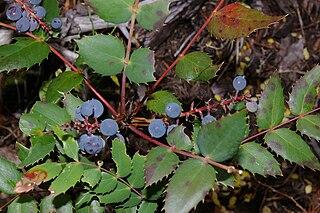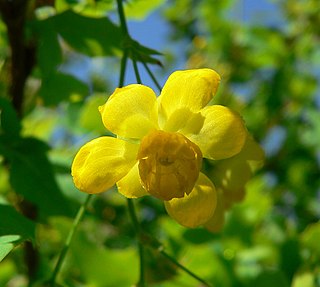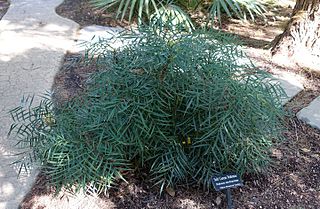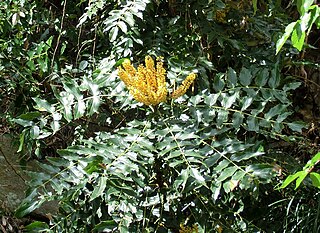
Mahonia is a formerly accepted genus of approximately 70 species of shrubs or, rarely, small trees with evergreen leaves in the family Berberidaceae, native to eastern Asia, the Himalaya, North America, and Central America. They are closely related to the genus Berberis and as of 2023 the majority of botanical sources list it as a synonym for Berberis.

Berberis nervosa, commonly known as dwarf Oregon-grape, Cascade barberry, Cascade Oregon-grape, or dull Oregon-grape, is a flowering plant native to the northwest coast of North America from southern British Columbia south to central California, with an isolated population inland in northern Idaho. It is especially common in second growth, Douglas-fir or western redcedar forests, making use of those pools of sunlight that intermittently reach the ground.

Berberis repens commonly known as creeping mahonia, creeping Oregon grape, or creeping barberry, is a species of Berberis native to most of the western United States and two western provinces of Canada. It has found use as a xeric ornamental plant and has escaped from cultivation in areas beyond its native range.
Berberis decipiens is a species of shrub in the Berberidaceae described as a species in 1913. It is endemic to Hubei Province in China. The species is listed as vulnerable by the IUCN.

Berberis fremontii is a species of barberry known by the common name Frémont's mahonia.

Berberis japonica is a species of flowering plant in the family Berberidaceae, native to Taiwan. Despite the name, it is not native to Japan, though it has been known in cultivation there for centuries. The wild origins of this species have long puzzled botanists, but wild plants in Taiwan, previously known under the name Mahonia tikushiensis, appear most similar to the cultivated forms of B. japonica.

Berberis fortunei is a species of shrubs in the family Berberidaceae, the barberry family, described as a species in 1846. It is endemic to China, found in the provinces of Chongqing, Guangxi, Guizhou, Hubei, Hunan, Jiangxi, Sichuan, Taiwan, and Zhejiang. It is grown as an ornamental in many lands, with common names including Chinese mahonia, Fortune's mahonia, and holly grape.
Berberis moranensis is a shrub in the genus Berberis in the family Berberidaceae. Because of its compound leaves, some botanists place it in the genus Mahonia. It is native to forested regions of the mountains of Mexico from Sinaloa and Guanajuato to Oaxaca. Berberis moranensis has thick waxy leaves, yellow flowers, and purple berries. This species is closely related to Berberis pimanaJ.E. Laferr. & J.S. Marr.

Berberis haematocarpa, Woot. with the common names red barberry, red Mexican barbery, Colorado barberry and Mexican barberry, is a species in the Barberry family in southwestern North America. It is also sometimes called algerita, but that name is more often applied to its relative, Mahonia trifoliolata.
Berberis bracteolata is a shrub in the Berberidaceae described as a species in 1917. It is endemic to China, known from Sichuan and Yunnan Provinces.
Berberis breviracema is a shrub in the Berberidaceae described as a species in 1985. It is endemic to China, native to Guangxi and probably Guizhou Provinces.

Berberis eurybracteata is a species of shrub in the Berberidaceae described as a species in 1901. It is endemic to China.
Berberis fordii is a species of shrub in the Berberidaceae described as a species in 1913. It is endemic to China, found in Chongqing and Guangdong Provinces.

Berberis gracilipes is a shrub in the family Berberidaceae, first described in 1887. It is endemic to China, native to the Sichuan and Yunnan Provinces.
Berberis hancockiana is a species of flowering plant in the family Berberidaceae, first described in 1917. It is endemic to Yunnan Province in southwestern China.
Berberis leptodonta is a shrub in the family Berberidaceae, first described in 1938. It is endemic to China, found in Sichuan and Yunnan Provinces.
Berberis longibracteata is a shrub in the family Berberidaceae, first described as a species in 1917. It is endemic to China, found in Sichuan and Yunnan Provinces.
Berberis monyulensis is a shrub in the family Berberidaceae first described as a species in 1961. It is endemic to Tibet.

Berberis napaulensis Nepali: जमाने मान्द्रो is a shrub in the family Berberidaceae described as a species in 1821. It is native to China and the Himalayas. This species is used medicinally throughout the Sikkim Eastern Himalayas.
Berberis standleyi is a shrub in the Berberidaceae described as a species in 1952. It was published with the name Mahonia glauca, a very different plant from Berberis glauca. Thus if one desires to consider Berberis and Mahonia as one genus instead of two, it is necessary to use a different name, i.e. Berberis standleyi.









